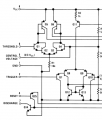I often use a 555 monostable with a switch as a trigger input, and so use a capacitor with 2 resistors to create a short pulse from a long switch to ground. See schematic. My question is, what does the diode do? I always include it, and I notice the trigger is unreliable if I don't. It's connected like a flyback diode, but there is no inductive element. I would think the cap totally discharges once the switch is opened, but apparently something is keeping the trigger pin at a potential even higher than VCC, correct? Can somebody please splain me? Thanks in advance.











